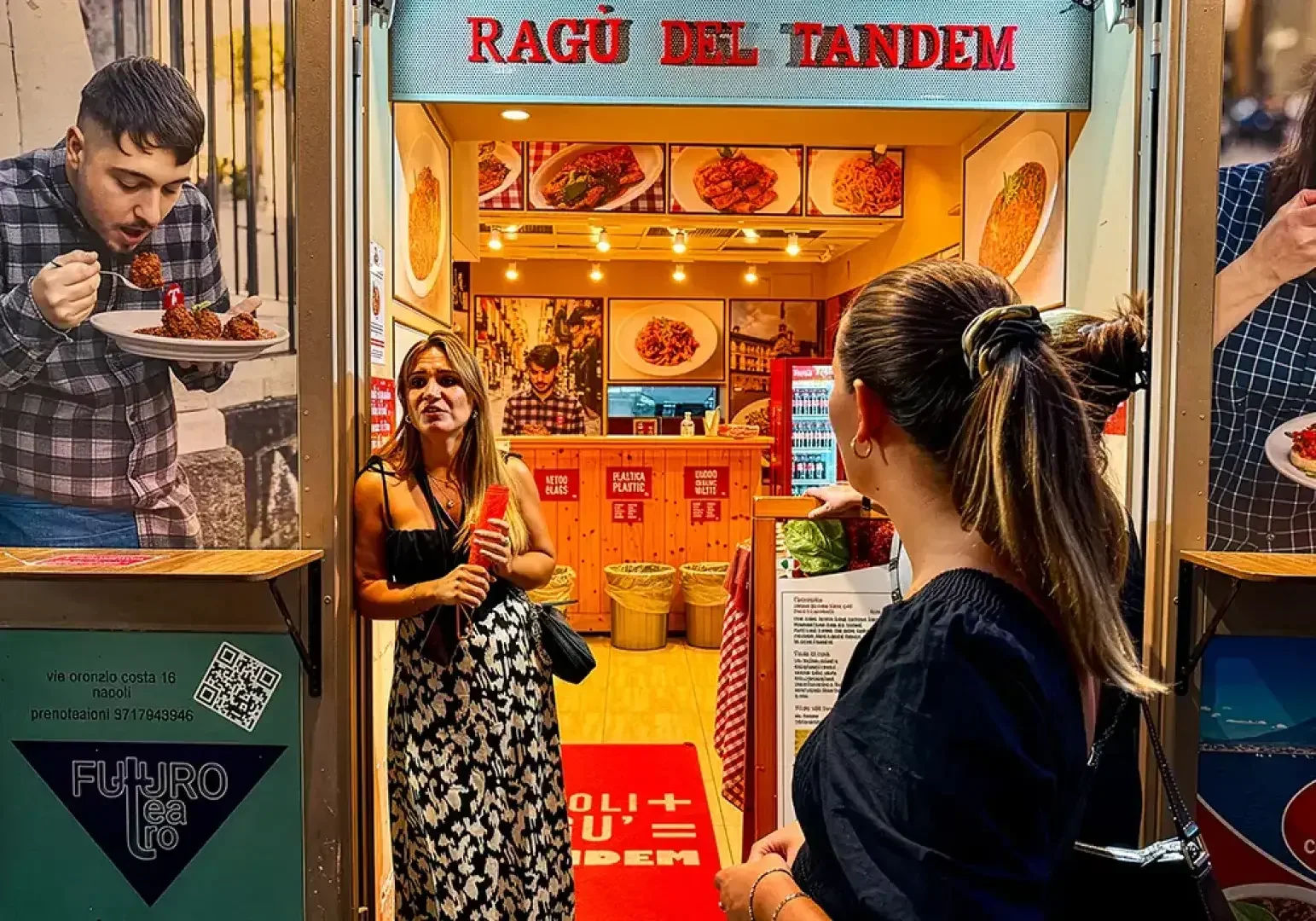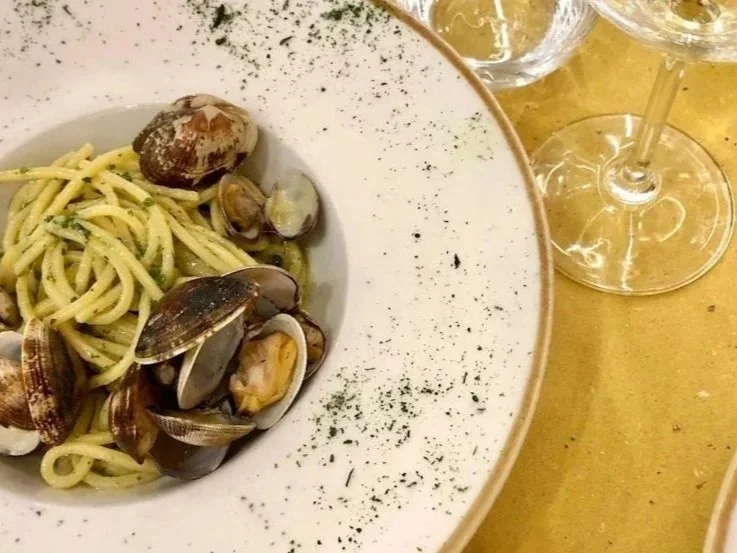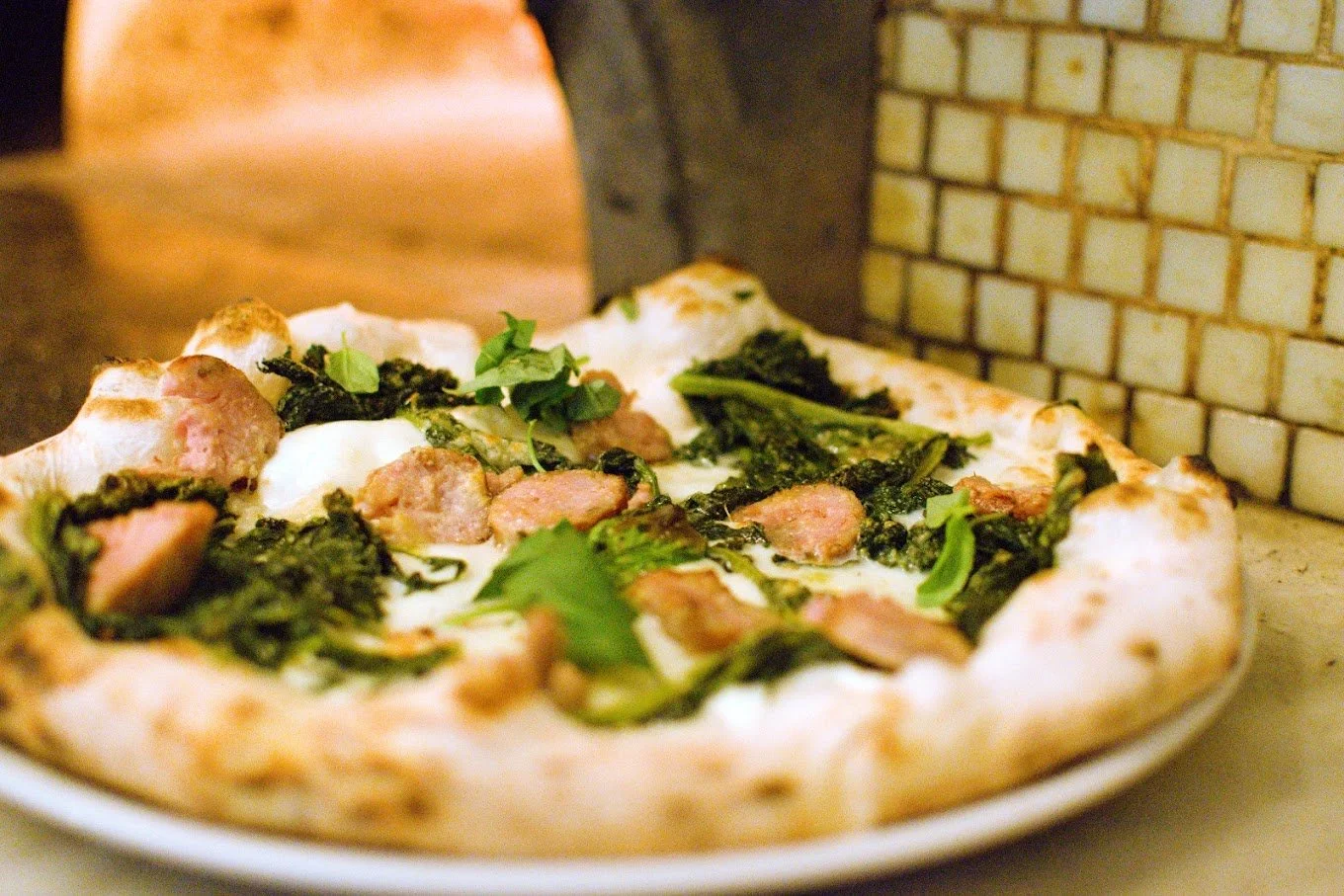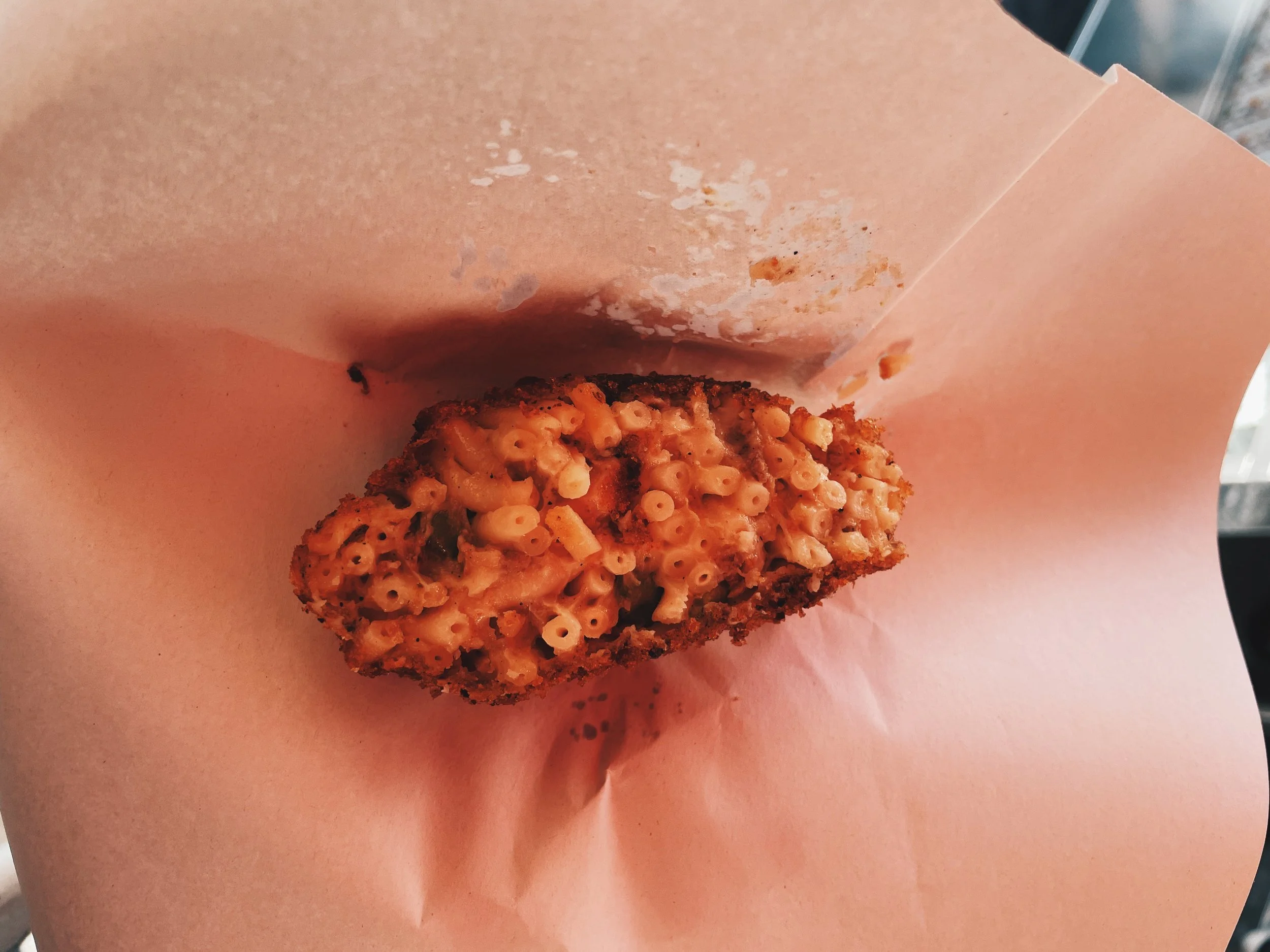What to Eat in Naples: Must-Try Dishes, Desserts, & Deep-Fried Goodies in the Birthplace of Pizza
This article may contain affiliate links. This means if you click a link on my blog and make a purchase, I may earn a commission at no additional cost to you.
Sampling Naples’ local and traditional cuisine is as important as visiting Pompeii or climbing Mount Vesuvius. In this Naples food guide, I share not only what to eat in Naples, but the backstory behind each and every bite.
Naples, the bustling heart of southern Italy, isn’t just famous for its stunning coastal views and historic streets. It’s also a city where food is a way of life. From world-famous pizza to rich pasta dishes, crispy street food, and irresistible sweets, Naples offers culinary treasures that tell the story of its culture, history, and local foodie traditions.
My entry point into the Neapolitan food scene was by way of a street food tour with Secret Food Tours (highly recommend!). Beyond the bites I was expecting, like pizza margherita, buffalo mozzarella, and sfogliatelle, there were plates I’d never even heard of, ones that are so deeply baked (or fried in this case) into Naples’ gastronomy that had I not been on the tour, I’m not sure I would have ever even known to look for them. And that would have been a real shame.
It was astounding to me that a food culture that has made its way and mark around the world had dishes that never did leave Naples’ borders—a realization that sent me on pursuit to go try absolutely everything I could get my hands on.
My hope is that this food guide to Naples sets you and your tastebuds up for a deep dive into Neapolitan food culture, not only what to eat, how to eat it, and where to eat it, but how each of these dishes was born—out of frugality, to impress nobility, or to celebrate a season. The combination of the what and the why behind each of these must-try Naples foods will make every bite taste that much better—promise.
Quick Note: Throughout this Naples food guide, I’ve marked vegetarian dishes with (V) and vegetarian-friendly options with (V option). Hope that’s helpful for my vegetarian readers!
Top 10 Must-Try Dishes in Naples
These are 10 of Naples’ must-try dishes—but this list is just the beginning so be sure to read this entire post where I break down what each of these dishes are (plus a few others), how to order them like a local, and exactly where to find their best version in Naples. In the list below, you can click on the dish and jump straight to its full description and where I recommend you try it.
Neapolitan Pizza: The Pride of Naples
When you think of pizza, chances are you imagine the classic margherita with its simple toppings of tomatoes, mozzarella, and basil. What you may not realize is that Naples is the birthplace of this beloved dish. While flatbreads with herbs, cheese, and other toppings have been enjoyed since ancient Greek and Roman times, it was the Neapolitans who transformed flatbread into the modern day pizza by adding tomatoes in the late 18th century.
Pizzerias began opening across Naples by the early 1800s, establishing the city as the undisputed home of modern pizza. By the late 19th century, pizza had risen to national fame with the creation of the pizza margherita, who some say was originally crafted by Raffaele Esposito in honor of Queen Margherita. The never-before-done combination of tomatoes, mozzarella, and basil was not only delicious but a symbolic nod to the colors of the Italian flag.
As we’re all well aware, the concept of pizza then traveled the globe, first carried by Italian immigrants to the United States and then to every corner of this world. Today, the art of Neapolitan pizza-making is so cherished that UNESCO has recognized it as an intangible cultural heritage, ensuring that this culinary tradition continues to be celebrated for generations.
These days, pizza’s entire evolution can be found in Naples, from the foldable pizza a portafoglio to the classic margherita. Here are the many versions of pizza to try in Naples and where to taste them:
Pizza Margherita: The Classic Icon (V)
Pizza margherita is the quintessential Neapolitan pizza. Its roots in royal history make it more than just a meal, but a piece of Italian heritage. Traditionalists insist that it be made with San Marzano tomatoes, fresh mozzarella (preferably fior di latte or buffalo mozzarella), fresh basil, and a drizzle of olive oil, baked at high temperatures in a wood-fired oven. When you eat a margherita in Naples, notice its slightly charred crust, soft center, and simple, but vibrant flavors.
Local Tip: Ask to peek into the kitchen—the pizzaioli still use wood-fired ovens that have been in service for generations.
Where to Try It: Pizzeria Brandi — Steps from Piazza del Plebiscito, this historic pizzeria claims to have created the margherita in 1889 for Queen Margherita of Savoy.
Pizza Fritta: The Rebel Cousin (V option)
Pizza fritta is a deep-fried dough often stuffed with ricotta, pork cracklings (cicoli) , and provola cheese. Born in post-WWII Naples when ovens were scarce and ingredients expensive, it became an affordable, portable street food for the city’s working class. The frying gives it a crispy exterior and soft, chewy interior, while the fillings can vary depending on what’s on hand. Be warned, however: it’s surprisingly large and very filling, making it better suited to share or turn into two meals.
Fun fact: Pizza fritta earned its “rebel cousin” nickname for defying the rules of the classic wood-fired pie—and for proving that sometimes, breaking tradition might taste even better.
Where to Try It: La Vera Pizza Fritta da Gennaro Pizzeria Arenaccia — Beloved by locals, this unpretentious spot serves one of the best versions in town: golden, crisp, and stuffed to the brim.
Pizza a Portafoglio: Foldable, On-the-Go Pizza (V)
Pizza a portafoglio, or “wallet pizza,” is a small, folded pizza designed to be eaten while walking. Originating in 18th-century Naples, street vendors created it as a practical, inexpensive meal for the working class. Its convenient fold inspired the name, and it remains a beloved street food tradition today. Antica Pizzeria Port’Alba, one of the world’s first pizzerias, played a key role in popularizing this portable style. Eating one while wandering the streets is a true Neapolitan experience.
Local Tip: Many locals eat theirs al libretto (folded like a book) to keep the heat in and the sauce off their hands.
Where to Try It: Antica Pizzeria Port’Alba — Open since 1738, this landmark pizzeria stands at the gateway to Naples’ historic center and serves the classic folded pizza just as it was made centuries ago. Grab one piping hot, folded into quarters, and head down Spaccanapoli for the most authentic “walking lunch” in the city.
Recommended Pizza-Centered Tours & Experiences in Naples
Pizza-Making Workshop (via GetYourGuide)
For a hands‑on experience, consider a pizza‑making workshop. You’ll learn how to knead dough, stretch it like a true pizzaiolo, build a classic Margherita, and enjoy your creation with a drink—an authentic way to dive deeper into the city’s pizza culture. (Activity info: approx 2 hours, small group, from $45 per person)
Naples Pizza & Drinks Tour with Eating Europe
Join this pizza-centered tour and scout out authentic Neapolitan pizza joints with a local guide. Along the way, you’ll savor multiple pizza samples, enjoy limoncello spritz-style cocktails, and soak in the city’s culture and history, including stops at sites like the 15th-century Palazzo Venezia. (Activity info: approx 3.5 hours, small group, from $86 per person)
Search for more Naples food tours and experiences on Viator, GetYourGuide, and EatWith.
Related Content: Another famous Italian foodie city is Bologna. Check out my Bologna in a day blog post for more content that will make your stomach rumble.
Traditional Neapolitan Pasta and Mains: Hearty Flavors with History
Neapolitan cooking is a tapestry woven from centuries of cultural exchange, shaped by the Greeks, Arabs, and Spanish who passed through the city’s busy port. Nowhere is that legacy more deliciously expressed than in its pasta and main courses—dishes that combine humble ingredients with the warmth of family tradition and the patience of slow cooking.
The ancient Greeks and Romans made early dough-based dishes like laganon and lagana, forerunners of modern pasta, and introduced the region’s enduring love for olive oil and fresh herbs. Centuries later, Arab traders brought durum wheat and dried pasta—a game-changing innovation that allowed pasta to be stored and shipped, and Naples’ sunny climate made it the perfect hub for drying and production. By the 17th century, the city had become one of Europe’s centers of pasta-making.
Under Spanish rule, when poverty and scarcity defined daily life, pasta became the people’s food—affordable, filling, and adaptable. Neapolitans embraced it with such enthusiasm that they earned the nickname mangiamaccheroni (“macaroni eaters”). The arrival of the tomato from the Americas in the 16th century completed the story and by the 19th century, rich tomato sauces were everywhere, turning simple pasta dishes into culinary icons.
But Naples’ genius for transforming modest ingredients didn’t stop at pasta. The same ingenuity shaped its hearty ragùs, vegetable casseroles, and meat-and-greens combinations, each dish grounded in local produce and a love of strong, honest flavors.
Whether simmered, layered, or sautéed, the pasta and mains that follow are foods that reflect the Neapolitan gift for elevating the everyday into something your tastebuds won’t soon forget.
Ragú Napoletano: A Sunday Ritual
Few dishes capture the soul of Naples like ragù napoletano. This slow-cooked sauce blends pork and beef, simmered for hours in tomato sauce until the meat is tender and the flavors meld into a rich, velvety ragù. Traditionally, it’s served over pasta—often ziti—on Sundays, filling homes with its irresistible aroma. If not over pasta, it can also be eaten with meatballs (polpette), as a filling for bread in a "cuzzetiello" sandwich, or simply as a sauce to dip bread into (scarpetta).
Where to Try It: Tandem — a local favorite renowned for its ragù, served in generous portions with the option to scarpetta (sop up the sauce with bread), just like the locals do.
Spaghetti alle Vongole: The Taste of the Sea
Spaghetti alle vongole (spaghetti with clams) embodies Naples’ seaside heritage. This dish relies on the freshness of its ingredients: just olive oil, garlic, parsley, white wine, and sweet, briny clams. Its simplicity is deceptive—when done right, it’s perfection on a plate. Originating from the city’s fishermen who cooked their catch right by the shore, it remains a staple in Neapolitan homes and trattorias alike.
Where to Try It: La Locanda Gesù Vecchio — tucked in the heart of the historic center, this cozy trattoria serves an authentic version rich with local clams and the perfect balance of sea and spice.
Pasta e Fagioli (“Pasta Fasule”): Humble & Hearty (V option)
Meaning “pasta and beans,” pasta e fagioli is a rustic classic that also speaks to Naples’ resourceful spirit. Born from peasant cooking, it combines pasta, beans, olive oil, and sometimes a bit of pork or mussels. In the past, it was a way to stretch limited ingredients into something nourishing and satisfying. It remains beloved for its hearty flavor and comforting warmth.
Where to Try It: La Taverna a Santa Chiara — known for its homestyle cooking, this spot serves pasta e fagioli that tastes like it came straight from a Neapolitan grandmother’s kitchen.
Salsiccia e Friarielli: The Bold Pairing
If you want to taste Naples’ more assertive side, try salsiccia e friarielli—sausage paired with bitter greens similar to broccoli rabe. The combination of spicy, juicy sausage and slightly bitter friarielli creates a perfect balance that locals adore. This dish is often enjoyed as a main course with bread or potatoes or as a pizza topping, embodying the city’s love for strong, earthy flavors.
Where to Try It: La Lazzara Trattoria e Pizzeria — a lively spot where this classic pairing is served either plated or on pizza, just as Neapolitans enjoy it.
Parmigiana di Melanzane: Layers of Comfort (V)
Known elsewhere as eggplant parmesan, parmigiana di melanzane is layers of fried eggplant, tomato sauce, basil, and cheese baked until bubbling and golden. Though its exact origins are debated—some claim Sicily, others Campania—there’s no question it captures southern Italy’s love of simple, seasonal ingredients transformed through patience and care.
Where to Try It: Enoteca e Trattoria La Cantinetta — an intimate spot offering a delicate, traditional Parmigiana that pairs beautifully with a glass of local Aglianico wine.
Want to roll up your sleeves and make pasta in a local’s kitchen?
For a deeper dive into Neapolitan cooking, consider the Pasta-Making Class & Dinner with a Local experience (via GetYourGuide). You’ll learn to make traditional pasta from scratch, get to enjoy the fruits of your labor with local wine, and do all of it inside of a Neapolitan home. (Activity info: approx 2 hours, small group, from $60 per person)
Naples Street Food and Appetizers: Grab-and-Go Neapolitan Cuisine
If pasta is Naples’ heart and pizza its pride, then street food is its soul. For centuries, mealtime in Naples has often been on-the-go—from dockworkers and market sellers grabbing a bite between shifts to travelers stealing bites of arancini or pizza a portafoglio while weaving through the narrow lanes of the historic center. For Neapolitans, this street food culture grew from necessity: simple, hearty food that could be eaten without plates or cutlery, often sold right from the frying pan or oven door.
The tradition blossomed in the 18th and 19th centuries, when resourceful cooks turned scarcity into creativity. Fried delicacies like pizza fritta (born after World War II, when ovens were scarce) and the foldable pizza a portafoglio reflect the city’s knack for turning hardship into flavor. Over time, these humble inventions joined other street classics like cuoppo—paper cones filled with fried seafood or vegetables—and frittatina di pasta, a creamy, golden-fried pasta cake.
Today, the streets of Naples are still alive with the scent of sizzling oil and fresh dough. Whether you’re wandering Spaccanapoli or exploring the Spanish Quarter, you’ll find that eating con le mani (with your hands) isn’t just convenient, it’s a cherished Neapolitan tradition.
Here’s what to eat in Naples standing up and on-the-go:
Cuoppo: The Cone of Plenty
A cuoppo is a paper cone overflowing with golden fried goodness—from fish (cuoppo di pesce fritto) to mixed vegetables, calamari, shrimp, and even zeppoline (tiny fried dough puffs). This Neapolitan classic dates back to the 19th century, when vendors would serve small portions of fried street snacks wrapped in old newspaper. The modern version, thankfully, uses cleaner paper but preserves the same spirit: a feast meant to be eaten by hand, hot and crisp.
Where to Try It: Il Cuoppo San Biagio Dei Librai — Right off Via San Biagio dei Librai, this spot serves traditional mixed cones fried to order. Order a cuoppo misto and stroll through the old town for the quintessential Naples experience.
Frittatina di Pasta: The Ultimate Leftover Reinvention (V option)
Born from ingenuity, frittatina di pasta takes leftover pasta and transforms it into something irresistible. Mixed with béchamel, peas, and ham, then battered and deep-fried, it’s crispy outside and creamy and gooey inside. It’s comfort food in its most portable form. This dish likely emerged in the 20th century from frugality, when home cooks refused to waste even a handful of pasta. Today, it’s a star of Naples’ fried food scene and one of my personal favorite Neapolitan dishes.
Where to Try It: Antica Pizzeria Di Matteo — One of Naples’ most iconic friggitorie (fry shops) on Via dei Tribunali, known for perfect frittatine and pizza fritta. Anthony Bourdain once stopped here—and for good reason.
Arancini: Golden Rice Balls of Sicily, Neapolitan Style (V option)
While arancini originated in Sicily, Naples made them its own. These deep-fried rice balls, filled with creamy mozzarella or ragù, became a staple of southern Italian snack culture thanks to their portability and satisfying crunch. The Neapolitan versions are typically smaller and cheesier, perfect for eating in two or three bites.
Local Tip: Arancini is even better when hot and fresh. The cheese pull alone makes it worth a try.
Where to Try It: Friggatoria Vomero — Known for its perfectly fried arancini, this neighborhood fry shop is a local favorite and a must-stop for an authentic taste of Naples’ take on this classic.
Mozzarella in Carrozza: The Crispy Cheese Sandwich from Naples (V)
Literally “mozzarella in a carriage,” this indulgent snack sandwiches molten mozzarella between two slices of bread, coats it in egg and breadcrumbs, and fries it to golden perfection. Its origins lie in the thrifty kitchens of southern Italy, where leftover bread and cheese were never wasted. It’s comfort food at its simplest—hot, stretchy, and, yes, slightly messy.
Where to Try It: Antica Friggitoria Masardona — Famous for its fried specialties, this historic fry shop has been feeding locals since 1945. Their mozzarella in carrozza is crisp on the outside, gooey within—exactly as it should be.
Casatiello: A Bread for Celebration
Casatiello isn’t everyday street food, but it’s an important part of Neapolitan culinary culture—especially around Easter. This savory, ring-shaped bread is stuffed with cheese, salami, and pancetta, and traditionally topped with whole eggs baked into the dough. It symbolizes abundance and renewal, eaten during spring picnics or festive gatherings. While you’ll see it most often during Easter, many bakeries make mini versions year-round.
Local Tip: Pair it with a glass of red Aglianico wine if you spot Casatiello freshly baked—it’s the taste of Neapolitan celebration.
Where to Try It: Panificio Malafronte — A local bakery that still prepares casatiello the old-fashioned way, rich with peppery cheese and smoky cured meats.
Want to taste Naples’ street food scene with a local?
Free Walking Tour Through Pignasecca Market (via GuruWalk)
Budget-Friendly Option: Join the Pignasecca Market Free Walking Tour (bookable via GuruWalk) and wander one of the city’s oldest markets with a passionate local guide. Sample favorites like frittatina di pasta, provolone del monaco, and creamy espresso at your own pace, paying only for what you try. It’s flexible, immersive, and perfect for travelers who might be on a budget, but want the local expertise. (Activity info: approx 2 hours, pay-as-you tastings, free/tip-based tour)
Guided Street Food & Culture Tour with Secret Food Tours
All-Inclusive Option: For a guided, taste-it-all adventure, Secret Tour’s Guided Street Food & Culture Tour leads you through Naples’ historic center from Piazza Dante to Piazza del Gesù Nuovo. Along the way, you’ll enjoy pizza, sauces, pastries, and more, while learning about the city’s culinary traditions from a local. It’s perfect for food lovers who want everything curated and explained in-depth. (Activity info: approx 3.5 hours, all-inclusive, from $95 per person)
Search for more street food experiences in Naples on Viator, GetYourGuide, GuruWalk, and EatWith.
Related Content: Heading to Florence next? Be sure to read my Florence City Guide, full of tips and content on where to stay, eat, explore, and more.
Sweets & Pastries: Indulgent Neapolitan Desserts
If Naples has a love language, it’s written in sugar, cream, and rum syrup. Neapolitan desserts are more than indulgences—they’re edible symbols of faith, festivity, and family, deeply tied to the city’s history and religious calendar. Each sweet tells a story of celebration, whether crafted in convent kitchens, sold in bustling pastry shops, or served during centuries-old festivals.
Naples’ confectionery heritage draws from a blend of Arab, Spanish, and French influences, layered with local creativity. The use of wheat, citrus, and ricotta harks back to ancient Mediterranean ingredients, while Spanish and Bourbon rule introduced refined baking techniques and exotic spices. Many recipes were perfected in the cloisters of Naples’ monasteries, where nuns were renowned for creating divine pastries for feast days—literally and spiritually.
Here are the sweets to try in Naples:
Sfogliatella: The Iconic Shell Pastry of Naples (V)
A true emblem of Neapolitan pastry art, the sfogliatella was born in the 18th century at the Santa Rosa convent on the Amalfi Coast. Its name means “small, thin leaf,” referring to the delicate, layered pastry that encloses a rich filling of sweetened ricotta, semolina, and candied citrus. In Naples there a two versions: sfogliattela riccia and sfogliatella frolla. The main difference is in the crust, not the filling: the riccia has a flaky, layered seashell-shaped crust, while the frolla (see picture) has a smoother shortcrust pastry shell. Pair either version with a cappuccino and you have the perfect Neapolitan breakfast.
Where to Try It: Sfogliatella Mary near Galleria Umberto I—a classic stop for perfectly flaky shells.
Pastiera: Easter’s Sacred Sweet (V)
This fragrant tart of ricotta, cooked wheat, and orange blossom water has been a symbol of Neapolitan Easter for centuries. Legend says a mermaid offered it to the gods as a gift of harmony, but in reality, it was likely created by nuns at the Convent of San Gregorio Armeno who baked it to celebrate spring and renewal. Its perfume of orange and vanilla fills homes across Naples during Holy Week—a reminder that in this city, food and faith really do intertwine.
Where to Try It: Scaturchio in Piazza San Domenico Maggiore—a historic pastry shop beloved by locals.
Babá: The Rum-Soaked King of Neapolitan Desserts (V)
Soft, spongy, and irresistibly boozy, the babà is perhaps Naples’ most famous dessert export. Though it originated in France and Poland, Neapolitans made it their own, soaking the yeast cake in rum syrup until it gleams with sweetness. You’ll find it in every shape and size—from classic mushroom-shaped versions to modern twists filled with cream or fruit.
Where to Try It: Pintauro on Via Toledo—one of Naples’ oldest and most storied pastry shops.
Zeppole di San Giuseppe (V)
Made to honor Saint Joseph on March 19th, these golden, deep-fried choux pastries are filled with silky custard and topped with cherries. Once sold by street vendors during spring festivals, zeppole remain a beloved seasonal tradition—though you’ll still find them in pastry shops year-round. Their combination of crisp shell and creamy filling is absolutely delicious.
Where to Try It: Poppella Pasticceria in the Rione Sanità neighborhood—a local favorite for festive sweets.
Migliaccio Napoletano: Carnival’s Creamy Secret (V)
Often overlooked by visitors, migliaccio is a soft, custard-like cake made from semolina, ricotta, and lemon zest—simple ingredients transformed into something truly luxurious. Traditionally baked during Carnival, before Lent, it’s yet another example of Naples’ talent for turning frugality into art. Once made with millet (miglio), this humble dessert has evolved into a cherished comfort food that, to many Neapolitans, tastes of home, memory, and the citrus groves of Campania.
Where to Try It: Most locals bake it at home, but during Carnival you can find excellent slices at Pasticceria Capparelli or Scaturchio.
Mostaccioli: Chocolate and Spice from the Old World (V)
Diamond-shaped and covered in a glossy chocolate glaze, mostaccioli are Naples’ answer to gingerbread—firm, spiced biscuits that appear in every bakery window during the Christmas season. Their roots trace back to the Middle Ages, when Arab traders brought exotic spices like cinnamon and cloves to southern Italy. Neapolitan bakers combined these flavors with local almonds and honey, creating a cookie that’s as aromatic as it is nostalgic for Neapolitans.
Where to Try It: Pasticceria Carraturo near Porta Capuana—a family-run bakery known for its holiday classics.
Roccocò: The Taste of Neapolitan Christmas (V)
Shaped like golden rings and infused with almonds, candied citrus, and warm spices, roccocò are the quintessential Christmas biscuit in Naples. Their name comes from the French rocaille (“rockwork”), a nod to their hard texture—traditionally softened by dipping in sweet wine or liqueur. Baked since the 14th century, they were first made in convents, where nuns prepared them as festive gifts. To this day, roccocò mark the start of the Neapolitan holiday season—crisp, fragrant, and best enjoyed with friends.
Where to Try It: Pintauro or Scaturchio during December—both carry excellent traditional versions.
Want to explore Naples through its desserts and culinary secrets?
Join this Neapolitan Sweets and Street Food Tour (via GetYourGuide) with chef Anna, a certified Cesarina and local expert. In about 3 hours, you’ll stroll through the historic center, tasting iconic pastries like sfogliatella, babà, and torta caprese (a flour-less chocolate and almond cake), stopping at chocolate shops and the city’s best gelaterias, all while learning the stories, traditions, and superstitions behind Naples’ sweets. Anna also shares tips for preparing the perfect tiramisu and other classic recipes, giving you a full cultural and culinary experience. (Activity info: approx 3 hours, small group, from $50 per person, tastings not included, available in English or Italian)
FAQ: Eating in Naples (What Travelers Ask Most)
-
Naples is best known as the birthplace of pizza—especially pizza margherita and pizza fritta. But the city’s food culture goes far beyond pizza: iconic dishes include ragù napoletano, spaghetti alle vongole, parmigiana di melanzane, frittatina di pasta, and classic desserts like sfogliatella and babà. In the guide above, you’ll find the best spots to try each dish.
-
Some of the most beloved spots include Sorbillo, Concettina ai Tre Santi, Da Michele, and 50 Kalò—but the “best” depends on what style you prefer. Naples has soft, classic styles, slightly crispier modern versions, and neighborhood pizzerias that locals swear by. For example, my personal favorite is actually at Pizzeria Brandi.
-
Yes — Naples has a huge street food culture, and most vendors are reputable and constantly serving fresh, hot items. Stick to busy spots, choose fried items made to order, and avoid anything that’s been sitting out. Scroll to the street food section of this guide for a few trusted street food places for cuoppo and frittatina.
-
Naples is one of the most affordable food cities in Italy. Expect:
Pizza: €5–€10
Pasta dishes: €10–€16
Street food (cuoppo, frittatina, sfogliatella): €2–€5
Coffee: €1–€2
High-end restaurants exist, but eating well on a budget is easy here.
-
For popular pizzerias and modern trattorias, yes — especially on weekends or in peak season. Classic pizzerias often use a ticket system instead of reservations, so be prepared to wait (but the lines move fast). Street food spots slinging pizza fritta and ragú never require booking, of course.
-
Definitely. Naples has a strong vegetable-forward tradition: parmigiana di melanzane, fried zucchini blossoms, marinated vegetables, pizzas without meat, and plenty of seafood-less pasta. I highlight the best vegetarian-friendly dishes in the guide.
-
Yes — Naples’ tap water is safe and famously good, sourced from springs near Mount Vesuvius. Many restaurants will still default to bottled water, but you can ask for “acqua del rubinetto.”
-
Locals typically eat around 8:00–9:30 pm. Many restaurants open at 7 pm, but the atmosphere becomes lively later. Street food spots run earlier and stay open late.
-
Top picks include sfogliatella riccia from a bakery, local olive oil, limoncello from the Amalfi Coast, dried pasta from Gragnano, and Neapolitan coffee blends. I really should write a whole post on this…hmm….
These deep dives into destinations and culinary traditions are my passion, but they don’t always pay the bills.
If you’d like to support my work, one of the best ways to do so is to book your tours, hotels, transportation, etc. via the links on my Travel Resources page. This sends a bit back my way at no additional cost to you. If you just want to say thanks, you’re always welcome to make a donation at Buy Me a Coffee or to become a paid subscriber on my Substack. Thank you so much!



























Whether you’re working or studying, Florence has more than a few spots that welcome the laptop-clad crowd. In this post, I share the coffee shops, study nooks, and cafe-restaurants that served as my “office” in Florence.